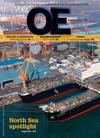
Page 87: of Offshore Engineer Magazine (Aug/Sep 2014)
Read this page in Pdf, Flash or Html5 edition of Aug/Sep 2014 Offshore Engineer Magazine
EyebrowProduction interfaces and collaboration, as well as
What’s involved in preparing to decommission?
identify dependencies, impacts, and risks across the business.
Safety
By taking an overview of the decision • HAZID / HAZOP
TechnicalTechnical making process, Marathon Oil can priori- • Quantitative risk • Data gap assessment• Data gap assessment
Societal assessment tize and focus its efforts. It believes this • Integrity surveys• Integrity surveys • Fishing impacts • Human factors impacts has helped signi? cantly in communicat- • Process / utility• Process / utility • Noise and air • Safety case strategy decommissioning studiesdecommissioning studies ing with management and other stake- pollution •Other users of the sea • Well abandonment• Well abandonment holders, which in turn has led to a formal • Employment • Removal method • Removal method assessment impacts interface management and an improved • 3D laser model surveys• 3D laser model surveys way of working.
Environment • Weight / CoG• Weight / CoG
With more than £40 billion anticipated • EIA • Subsea and pipelines• Subsea and pipelines decommissioning spend in the next 10
Process • Seabed sampling • Cleaning methods management years in the UK North Sea alone, it’s clear • Drill cuttings mapping • Stakeholder that planning for decommissioning is • Waste inventory relationships critical to success and that while every • Hazardous waste • Independent
Economics asset is unique, many face similar plan- mapping veri?cation • Field life economics • Impacts on mammals, ning challenges. DNS believes that the • Independent • Work scope cost estimates birds, ?sh chairmanship “appraise, select, de? ne, and execute” creation of a decision planning roadmap • Taxation implications • Energy and carbon approach does not adequately address and toolbox could be of signi? cant value emissions the unique features of decommissioning. to the industry to help map out that
Images from Decom North Sea
A series of workshops facilitated by journey.
Decom North Sea (DNS) with a group summarised in a decommissioning pro- indicating key decisions, when they need of operator and contractor members, is gram, which is submitted to government to be made and by whom. DNS believes Dorothy Burke discussing decommissioning or “retiring” (the Department of Energy and Climate that creating such a tool box would assist facilitates Decom an asset as a new phase in its life-cycle, Change) using a standard template for- in decommissioning projects of different North Sea’s projects rather than treating it as a new project. mat, which DNS worked with industry sizes and complexity, and would enable and initiatives,
The proposed retire-phase recognizes the and DECC to create. decommissioning teams to better scope bringing together transition from operation to decommis- In contrast, at the moment there are no the planning process and the impact of operators, major sioning. This distinction, while seem- standard planning processes or proce- decision making throughout the transi- contractors and the ingly small, will enable the industry to dures in place to manage the transition tion phase. supply chain to look at things differently and help plan, from operations to decommissioning, Next steps are likely to be a call for collaborate on a range of decommission- communicate, prepare for, and manage and there is no documented toolbox for workgroup members to take part in a col- ing topics. the decommissioning effort. managing this series of events. There is laborative effort to create a documented Her previous experience covers technol-
The transition period from operations however, consistency in the decisions framework and develop a toolbox to ogy, innovation, and facilitation roles/ to decommissioning occurs over a period that need to be made, the timing at which address this need. contracts with oil and gas technology of time. Each asset is unique, but the these should be considered, and the Marathon Oil is a DNS member which facilitation organisation ITF, the Energy same options require consideration. Not key enablers for decommissioning to be champions the decision quality (DQ) Knowledge Transfer Network, the all elements of an asset mature at the successful. approach to project planning and deci- Innovation Relay Centre, and Connect. same time or pace; some are complete The aim of the initial workshops is to sion making. It takes a collective consen- prior to cessation of production (COP), learn from the approaches used by differ- sus on project decisions, by identifying Decom North Sea (DNS) is the indus- while others occur years after COP. This ent companies, identify the gaps in the which decisions are “key,” when they try body that facilitates this in the North results in multiple, targeted assessments decommissioning planning process, and should be made (both their timing and Sea. Since its inception in 2010, DNS has of readiness, with a complex series of de? ne what tools may be useful to assist their relationship to other decisions), grown to have more than 230 members, activities to be carried out in a certain planning during the transition phase. what options are available and what including operators, contractors, service order against a predetermined timescale. Elements discussed include planning selection criteria should be used. The DQ specialists, and technology developers.
When preparing for decommission- for 10 years before COP, a strategy matrix, approach also establishes who should be The group’s aim is to bring people from ing, there are a number of options that covering scope, control, contracting and involved in the decision making process, across the industry together to discuss the operator must consider. These are technology, and a decision road map, which has helped to initiate and manage opportunities and learn from one another.
oedigital.com August 2014 | OE 89 088_OE0814_ProdOps3.indd 89 7/23/14 3:04 AM

 86
86

 88
88